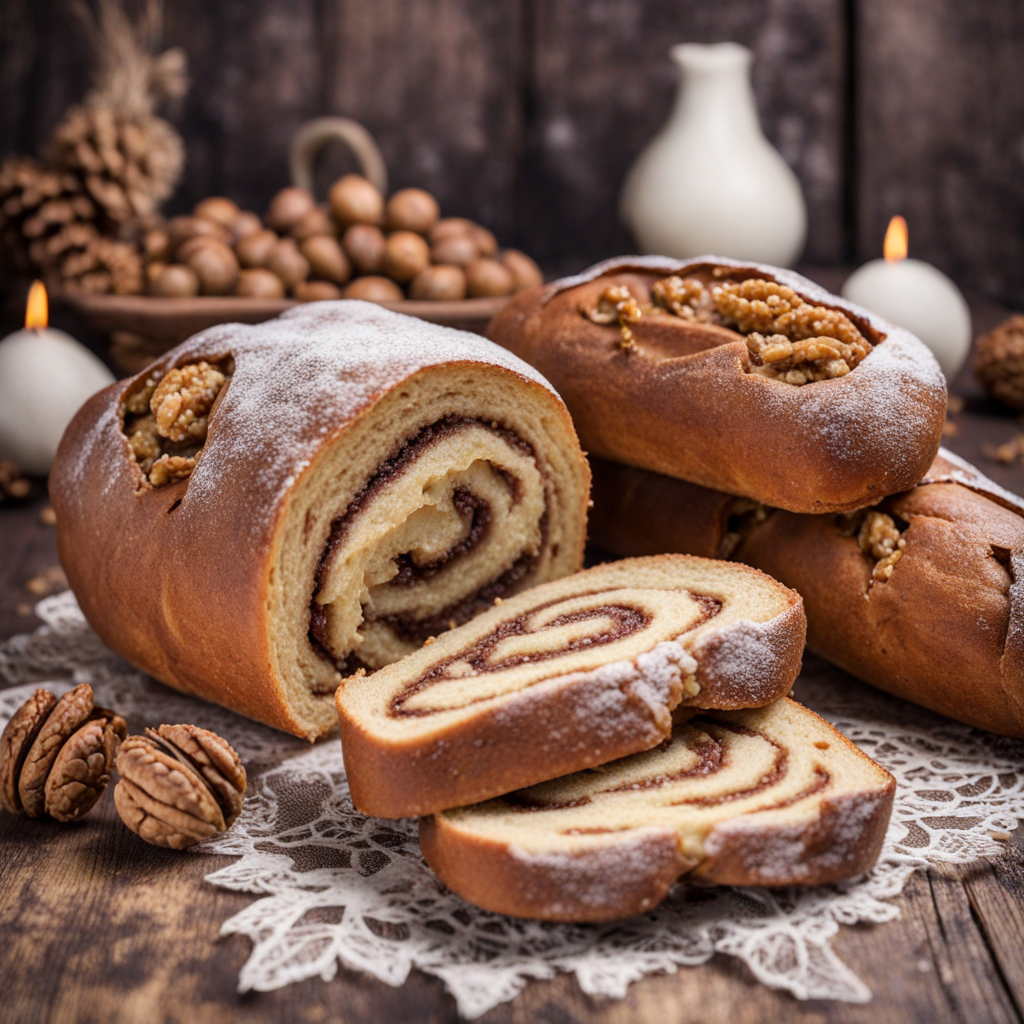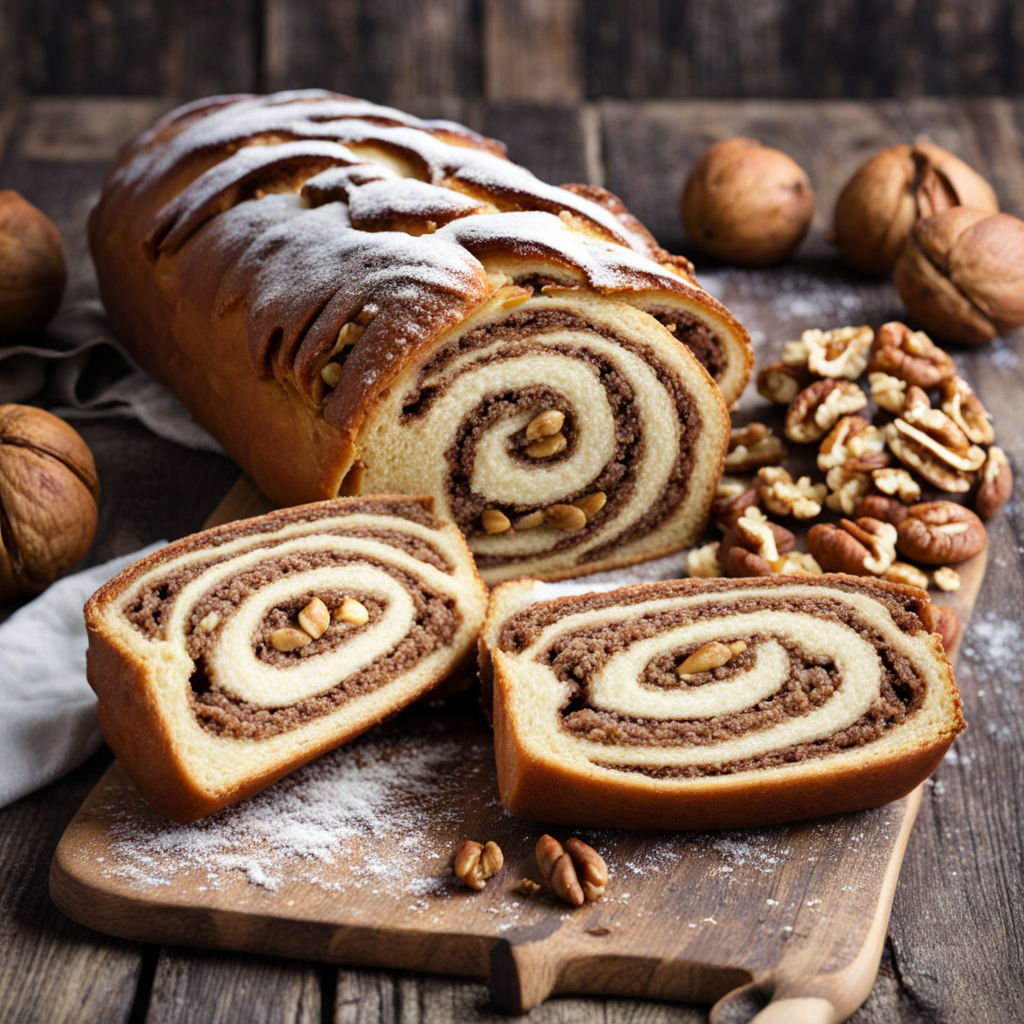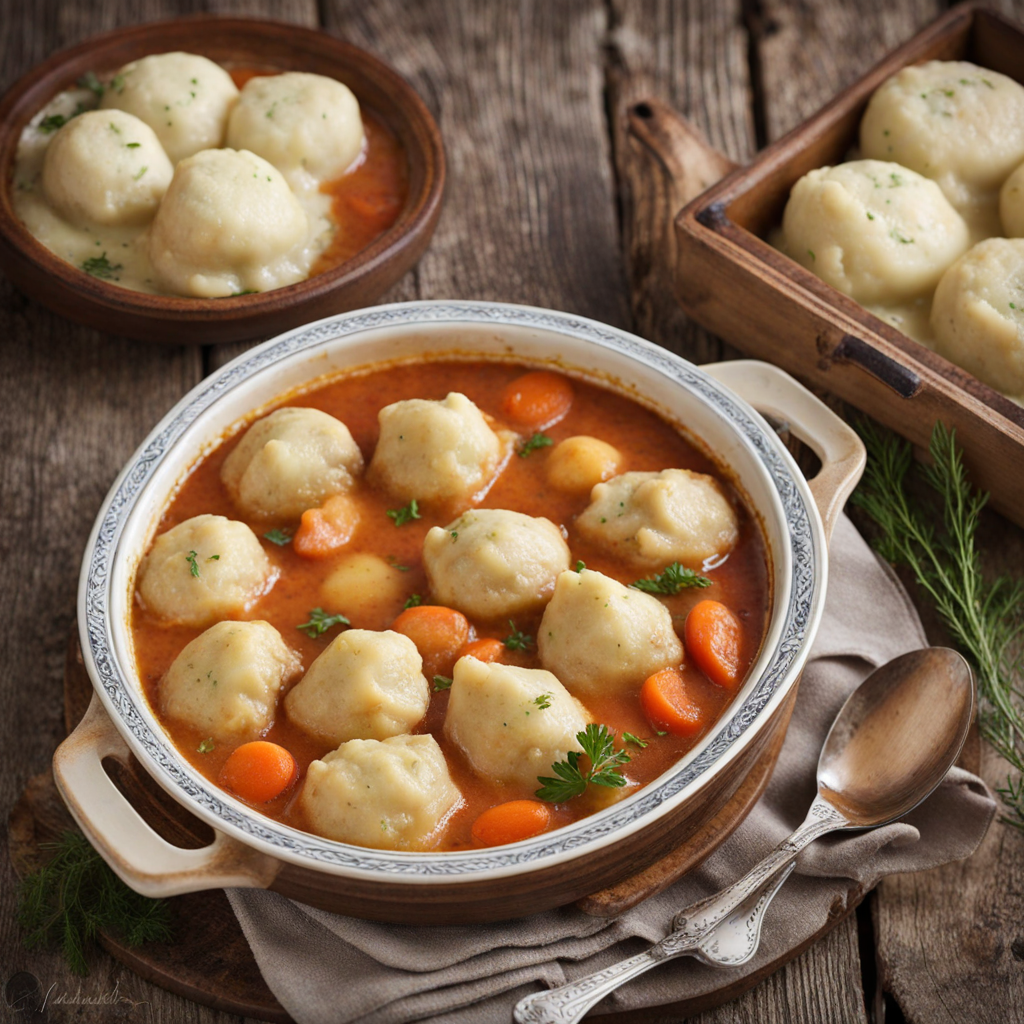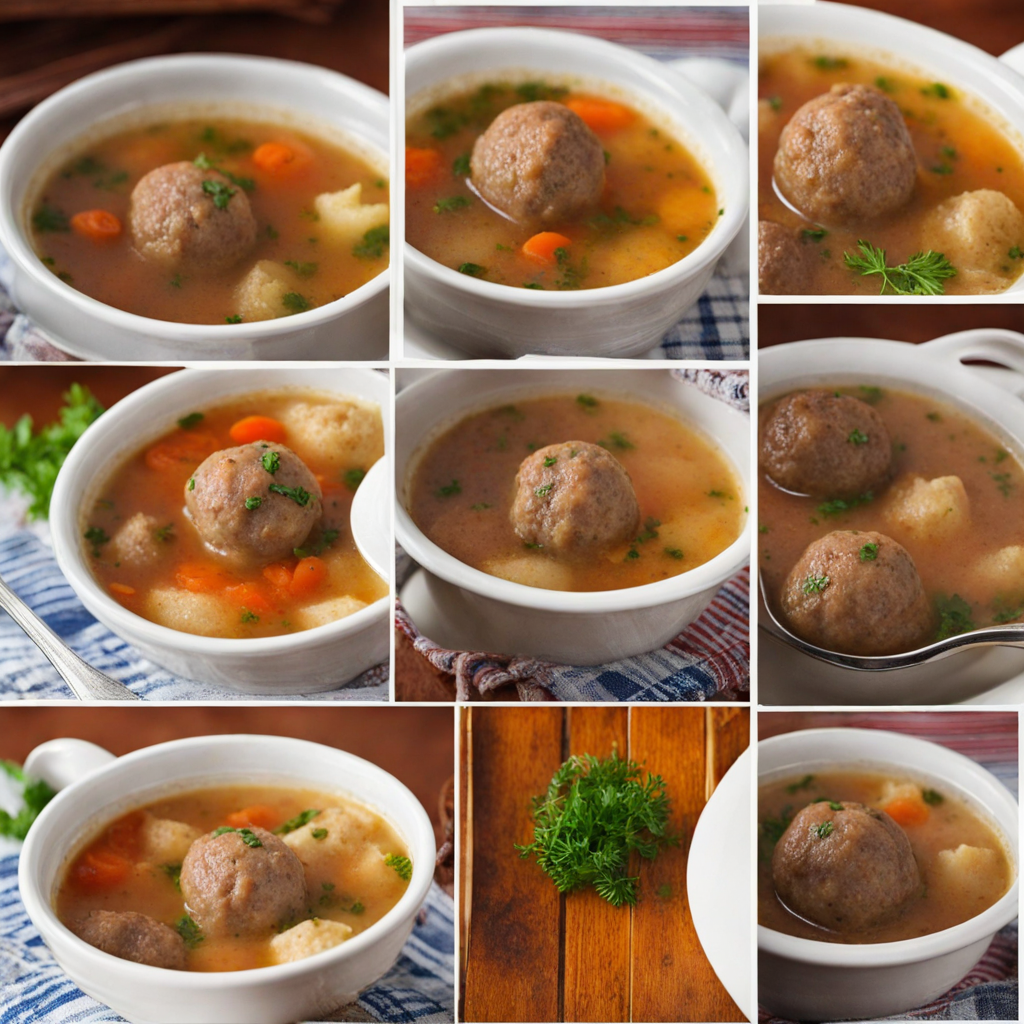Sweet Walnut Bread
Sweet Walnut Bread, known in Romania as "Pâine cu Nuci," is a delightful treat that embodies the rich culinary traditions of the region. This bread is characterized by its soft, slightly sweetened dough, which is often enriched with milk and eggs, lending it a tender crumb and a golden-brown crust. The star of the dish, however, is the generous filling of finely chopped walnuts, which adds a nutty richness that perfectly complements the subtle sweetness of the bread. Sometimes, a hint of vanilla or a sprinkle of cinnamon is included, elevating the flavor profile and creating an inviting aroma that fills the kitchen as it bakes. The preparation of Sweet Walnut Bread is a labor of love, typically involving the kneading of the dough until it's smooth and elastic. Once the dough has risen, it is rolled out and generously filled with the walnut mixture, often combined with sugar and perhaps a touch of honey for added sweetness. The rolled dough is then shaped into loaves, which are left to rise again before being baked to perfection. The result is a beautifully golden loaf that, when sliced, reveals swirls of dark walnut filling against the soft, sweet bread, making it not only a treat for the palate but also a feast for the eyes. Traditionally enjoyed at breakfast or during festive occasions, Sweet Walnut Bread can be served warm or at room temperature. It pairs wonderfully with a spread of butter or cream cheese, and a cup of tea or coffee enhances the experience. This bread is not just a culinary delight; it carries with it the warmth of Romanian hospitality and is often shared among family and friends, making it a cherished part of the country's food culture.
How It Became This Dish
Cozonac cu Nucă: A Sweet Tradition in Romanian Culinary Heritage The sweet aroma of freshly baked cozonac cu nucă wafts through Romanian homes, particularly around festive seasons, evoking a sense of nostalgia and belonging. This traditional Romanian sweet bread, filled with a rich walnut filling, is more than just a delicacy; it is a symbol of cultural identity, family gatherings, and centuries of culinary evolution. Origins of Cozonac Cozonac, a term derived from the Latin word "coxa," which means "to bake," has deep roots in the culinary traditions of Eastern Europe. Its origins can be traced back to ancient Roman times, where similar sweet breads were prepared for celebrations and religious festivities. However, it was during the Middle Ages that the cozonac began to take on its distinctive characteristics in the Romanian cultural context. The precise origins of cozonac are subject to debate, but it is widely believed that the recipe was influenced by various cultures that have settled or interacted in the region, including the Ottoman Empire, the Austro-Hungarian Empire, and neighboring Slavic nations. The Ottoman influence, for instance, introduced the practice of using rich, buttery dough, which is a hallmark of the cozonac preparation. Over time, this bread evolved, becoming a cherished staple in Romanian households. Cultural Significance Cozonac is deeply intertwined with Romanian cultural and religious traditions. It is typically prepared for significant occasions, such as Christmas and Easter, symbolizing joy, celebration, and abundance. In Romanian Orthodox tradition, the act of baking cozonac is sometimes imbued with spiritual significance. Families often prepare the bread together, reinforcing bonds and passing down culinary knowledge through generations. During Christmas, the preparation of cozonac can be a family event, with each member contributing to the process. The dough is often shaped into a braid or rolled, indicating unity and togetherness. Additionally, the filling of cozonac can vary, with walnuts, poppy seeds, or even cocoa being popular choices. However, cozonac cu nucă, with its rich walnut filling, is the most traditional and beloved variant. In rural communities, cozonac is also gifted to neighbors and friends as a gesture of goodwill, fostering a sense of community and togetherness. The bread's intricate preparation is often seen as a labor of love, embodying the spirit of hospitality that is a hallmark of Romanian culture. The Recipe and Preparation The making of cozonac cu nucă is an art form that requires time, patience, and skill. The basic ingredients include flour, sugar, eggs, milk, butter, yeast, and salt. The dough is typically enriched, resulting in a soft, fluffy texture that is both satisfying and indulgent. The preparation begins with activating the yeast, allowing it to froth, which is crucial for achieving the desired rise in the dough. Once the dough is kneaded and allowed to rise, it is rolled out and filled with a mixture of ground walnuts, sugar, and sometimes a hint of vanilla or lemon zest for added flavor. The layered dough is then rolled and shaped before being placed in a baking pan, where it undergoes a second rise. Baking cozonac is a sensory experience. As it bakes, the sweet and nutty aroma fills the home, creating an anticipation that is palpable. Once baked, the cozonac is often brushed with melted butter and sprinkled with powdered sugar, giving it an appealing sheen. Evolution Over Time Over the centuries, cozonac has witnessed various adaptations, reflecting the changing tastes and influences in Romanian cuisine. While the traditional cozonac cu nucă remains a staple, contemporary bakers have experimented with fillings and flavors, incorporating ingredients like chocolate, dried fruits, or even various spices to appeal to modern palates. In urban areas, artisanal bakeries have emerged, offering gourmet versions of cozonac, often using organic ingredients or unique flavor combinations. This has led to a resurgence of interest in cozonac, as younger generations seek to reconnect with their heritage while also exploring new culinary horizons. Cozonac has also gained international recognition, often featured in Romanian diaspora celebrations and food festivals. It serves as a bridge between cultures, allowing Romanians living abroad to share a piece of their identity through food. The bread’s rich history and delightful taste have made it a beloved dish not only within Romania but also among those who have experienced Romanian hospitality. Modern-Day Heritage Today, cozonac cu nucă continues to be a cherished symbol of Romanian culture. Its preparation is a ritual that brings families together during holidays and celebrations, reinforcing the importance of traditions in a rapidly changing world. Various culinary competitions and festivals in Romania celebrate the art of cozonac making, where bakers showcase their skills and creativity. In addition to its cultural significance, cozonac also embodies the values of patience, craftsmanship, and love that are central to Romanian identity. As families gather around the table to share slices of cozonac, they are not just enjoying a delicious treat; they are partaking in a legacy that connects them to their past, their community, and each other. Conclusion The journey of cozonac cu nucă from ancient times to the modern day encapsulates the rich tapestry of Romanian culinary history. It is a testament to the resilience and adaptability of cultural traditions, evolving while retaining their core significance. As the world becomes increasingly globalized, foods like cozonac serve as reminders of our roots, celebrating the flavors and customs that define us. In every fluffy slice of cozonac cu nucă lies a story—a story of migration, adaptation, and a deep-seated love for family and tradition. For Romanians, this sweet bread is not just food; it is a symbol of home, heritage, and the enduring bonds of community.
You may like
Discover local flavors from Romania







